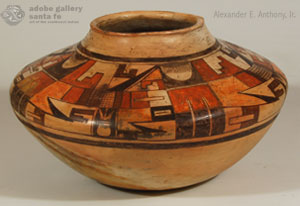Very Large Nampeyo Sikyatki-style Hopi Jar [SOLD]
+ Add to my watchlist Forward to Friend
- Category: Historic
- Origin: Hopi Pueblo, Hopituh Shi-nu-mu
- Medium: clay, pigment
- Size: 8” height x 13-3/4” diameter
- Item # C3926M SOLD
 The Hopi were wary of English-speaking intruders to their reservation because of their constant attempts to change Hopi ways. Very few Hopi spoke English, but many spoke Hopi, Tewa, Navajo and Spanish. Nampeyo’s brother, Tom Polacca was one of the few who spoke some English. It was for that reason that Thomas Keam, a young man the same age as Tom Polacca, struck up a friendship with Polacca and was introduced to Nampeyo.
The Hopi were wary of English-speaking intruders to their reservation because of their constant attempts to change Hopi ways. Very few Hopi spoke English, but many spoke Hopi, Tewa, Navajo and Spanish. Nampeyo’s brother, Tom Polacca was one of the few who spoke some English. It was for that reason that Thomas Keam, a young man the same age as Tom Polacca, struck up a friendship with Polacca and was introduced to Nampeyo.
Thomas Keam opened a trading post on the reservation in 1875, serving Navajo and Hopi, who came with goods to trade—hides, sheepskins, blankets, rugs, baskets and pottery. By 1879, the Smithsonian expressed interest in collecting from Southwest tribes before they were assimilated into the White culture. Over the next decade, tens of thousands of cultural items were taken from the villages at Hopi, both contemporary wares and prehistoric wares.
 As the museums continuously took items from Hopi homes, the Hopi made replacement items, which, then later, were added to the collections by museums. There was no understanding by the Hopi that the museums wanted the old items so they kept making new ones to fill the orders.
As the museums continuously took items from Hopi homes, the Hopi made replacement items, which, then later, were added to the collections by museums. There was no understanding by the Hopi that the museums wanted the old items so they kept making new ones to fill the orders.
Thomas Keam needed more pottery to satisfy the growing demand so he commissioned Nampeyo to produce pottery and to copy designs from the Sikyatki wares being unearthed. Nampeyo did not copy the designs but studied them and then “closed her eyes” and created designs of her own, albeit relying on the Sikyatki shards she saw.
 This magnificent jar presented here is a masterpiece by Nampeyo based on a prehistoric Sikyatki jar. The jar that most likely inspired Nampeyo was sold at Bonham’s auction in San Francisco in June 2017. Although not a direct copy, there is little doubt that that jar was the inspiration for Nampeyo’s masterpiece. The original Sikyatki jar was unearthed around 1895 and possibly purchased by Thomas Keam, either for his collection or to be for sale. It is recorded that it was purchased (from Keam?) around 1900 by Charles Lorin Owen, former curator of Southwestern art at the Field Museum in Chicago. From him, it passed to his grandson, then through several others until the sale at Bonhams.
This magnificent jar presented here is a masterpiece by Nampeyo based on a prehistoric Sikyatki jar. The jar that most likely inspired Nampeyo was sold at Bonham’s auction in San Francisco in June 2017. Although not a direct copy, there is little doubt that that jar was the inspiration for Nampeyo’s masterpiece. The original Sikyatki jar was unearthed around 1895 and possibly purchased by Thomas Keam, either for his collection or to be for sale. It is recorded that it was purchased (from Keam?) around 1900 by Charles Lorin Owen, former curator of Southwestern art at the Field Museum in Chicago. From him, it passed to his grandson, then through several others until the sale at Bonhams.
Although not a copy of the Sikyatki jar, this jar has remarkable similarity in design. It is quite likely that Nampeyo saw the Sikyatki jar while it was at Keams Trading Post before Owen took possession of it. She could have been commissioned by Keam to replicate the jar or she chose, herself, to replicate it. To state that Nampeyo did an exceptional job on this jar would be an understatement. Looking down on the top of the jar allows one to appreciate the complicated and well-organized design layout. There are triangles, rectangles, lines, curves, squares, dots, steps, hooks, and more, and they are beautifully interconnected.
It is likely that Nampeyo completed her jar in 1900-1905.
Condition: a small surface chip popped out at the rim and has been glued back in place
Provenance: this Very Large Nampeyo Sikyatki-style Hopi Jar is from the collection of a family from Colorado
Reference and Recommended Reading: Nampeyo and Her Pottery by Barbara Kramer.
Image: Nampeyo of Hano on the right with her daughter Fannie on the left - ca. 1930, courtesy of Rick Dillingham Fourteen Families In Pueblo Pottery.

- Category: Historic
- Origin: Hopi Pueblo, Hopituh Shi-nu-mu
- Medium: clay, pigment
- Size: 8” height x 13-3/4” diameter
- Item # C3926M SOLD



